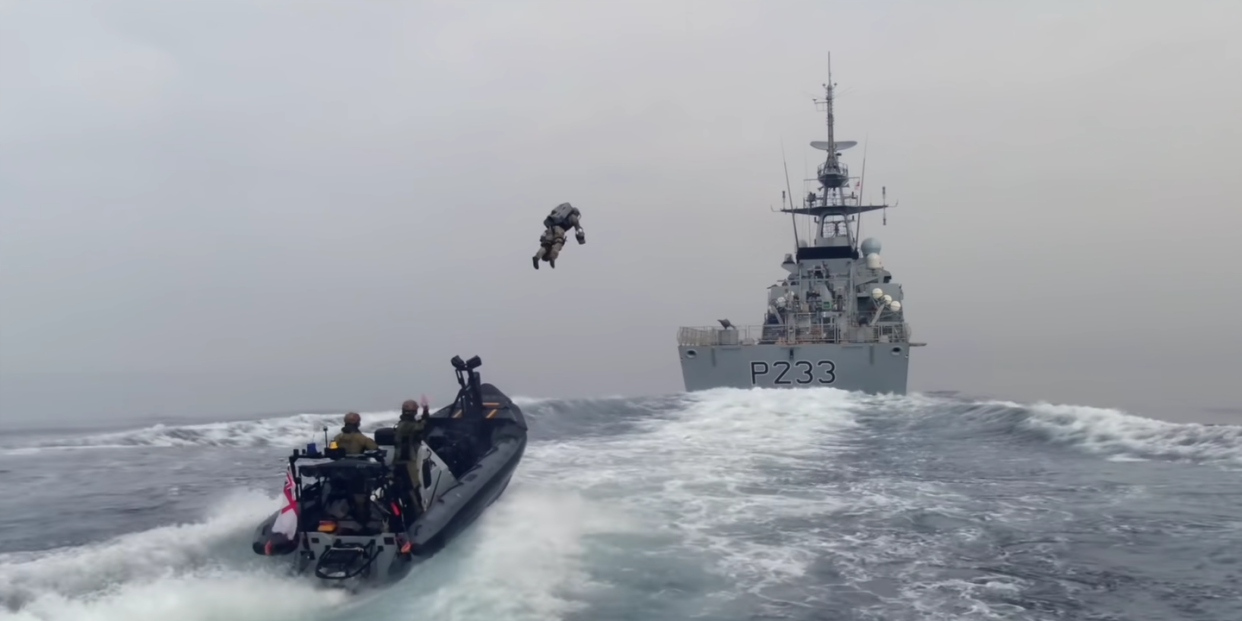Watch a Marine Zoom From One Boat to Another... With a Jetpack

A recent viral video depicts a man boarding a warship with a jetpack.
The video is real, but the man is a Royal Marine boarding a Royal Navy warship, not a U.S. Marine.
The jetpack was also recently used in a NATO search-and-rescue exercise.
A video from last spring—depicting a Royal Marine using a jetpack to launch himself from a moving boat to land on a nearby patrol boat—started to spread like wildfire across social media this week, leaving people to wonder if any of it was real. It turns out that a number of western armies are experimenting with the very same jetpack, which also made an appearance in a recent NATO exercise.
The video was reposted dozens of times on social media, in some cases dubbed over with terrible music that made it seem even less legit. But the footage is actually real. It illustrates a maritime boarding exercise that saw a Royal Marine taking off from a rigid-hull inflatable boat (RHIB) and landing on the stern of the offshore patrol vessel HMS Tamar.
🪖Don't miss our best-in-class military and defense coverage. Join our squadron.
You can watch the full video (above) courtesy of the jetpack's maker, United Kingdom-based Gravity Industries.
A number of western armies are experimenting with the Gravity Industries jetpack, including the United Kingdom's Royal Marines. The Royal Marines, at 8,000 personnel, are considerably smaller than their American counterparts, but training is longer and more grueling. The Royal Marines try to embrace new technologies and tactics to make up for a lack of numbers, hence their interest in the jetpack.
Gravity Industries' founder, Richard Browning, is a former Royal Marines reservist:
The HMS Tamar boarding incident is eight months old, as the video dates back to May 2021, but a more recent use of the jetpack took place at the NATO Mountain Warfare Center for Excellence in the mountains of Slovenia. The CASEVAC (casualty evacuation) scenario involved a missing person located in a gorge, and rescuers needed blood plasma to keep him alive. Participants used the jetpack to quickly bring lifesaving plasma to the rescue team.
The Gravity Industries jetpack is powered by a system of five micro turbine engines: two per arm and one on the pilot's back. The turbines generate a theoretical total of 1,050 horsepower, giving the pilot a top speed of 56 miles per hour. Browning says the company is working on electric and winged versions, too.
Gravity Industries' publicity comes at a time when the Defense Advanced Research Projects Agency (DARPA) is investigating single-person aircraft for short hops across the battlefield. The system could take the form of a jetpack, but it could also be something else, like a powered glider. Gravity's jetpack, which satisfies the five-kilometer flight requirement, appears to have the edge over competitors. If so, we could eventually see U.S. Marines strapping on those jetpacks, too.
You Might Also Like

